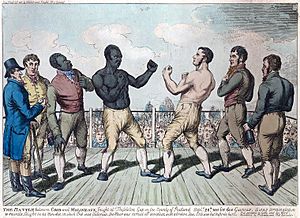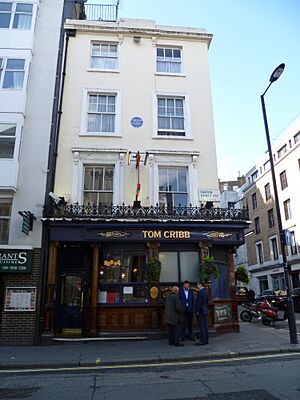Tom Cribb facts for kids
Quick facts for kids Tom Cribb |
|
|---|---|
 |
|
| Statistics | |
| Rated at | 189-199 lb |
| Height | 5 ft 9 in (175 cm) |
| Nationality | English |
| Born | 8 July 1781 Hanham |
| Died | 11 May 1848 (aged 66) London |
| Boxing record | |
| Wins | 15 |
| Losses | 1 |
Tom Cribb (8 July 1781 – 11 May 1848) was an English bare-knuckle boxer of the 19th century. He was All England Champion from 1808 to 1822.
Contents
Early life

Born in Hanham near Bristol, Cribb moved to London at the age of 13 and after working as a bell-hanger he sought work as a coal porter in Wapping.
Boxing career
His first fight was with George Maddox on 7 January 1805 at Wood Green in Middlesex, now part of north London. Victory over Maddox, followed by another over Tom Blake a month later, persuaded him to become a professional pugilist, under the supervision of Captain Robert Barclay.
George Nicholls was the only fighter to defeat Cribb, on 20 July 1805. Later, the foremost prizefighting reporter, Pierce Egan, stated that he was aware that some "friends of the CHAMPION" had encouraged the myth that Cribb enjoyed an unbeaten career by "withholding the name of his vanquisher" (Boxiana, vol. 1).
On 8 April 1807 Cribb beat Jem Belcher (who had been English champion from 1800-1805). The fight lasted 44 rounds and took place at Moulsey Hurst, the major prizefighting venue at the time. Following the retirement of reigning champion John Gully, Cribb fought Bob Gregson in October 1808 to determine the new English champion. This fight also took place at Moulsey Hurst and resulted in a win for Cribb in 23 rounds. Cribb then defended his title successfully at Epsom Downs Racecourse in a second bout against Jem Belcher on 1 February 1809.
On 18 December 1810 he fought an American, former slave Tom Molineaux, at Copthorne Common in Sussex. Cribb beat Molineaux in 35 rounds. The fight was controversial for two reasons: Molineaux was injured when the crowd invaded the ring, and Cribb at one point seemed to have taken longer than the specified time to return to the centre of the ring. Cribb then faced Molineaux again in 1811, beating him at Thistleton Gap in Rutland in 11 rounds.
Having beaten Gregson, Belcher and Molineaux, Cribb's reputation was so high that he received no further challenges for a further eleven years, and eventually retired from the ring in 1822. Dowling (1841) records that 'On 15th May 1822, Cribb publicly resigned the championship on the stage of the Fives Court, on which occasion he was presented with a belt, and was succeeded by Tom Spring'.
After retirement
Cribb became a coal merchant (and part-time boxing trainer). Later he worked as a pub landlord, running the Union Arms, Panton Street, close to Haymarket in central London.
In 1839 he relocated to Woolwich in south-east London where he died in 1848, aged 66. He was buried in the churchyard of St Mary Magdalene, Woolwich – where a monument to his memory was erected.
Legacy
Cribb's tomb, in the shape of a lion resting his paw on an urn, still stands in St Mary's Gardens in Woolwich. Also in Woolwich, a road in the Royal Arsenal area has been named in his honour.
The Tom Cribb pub is located at 36 Panton Street, St James, London. This is the same address as the Union Arms, which was originally 26 Panton Street, but later renumbered.
There is a popular local legend in the Bristol area that Cribbs Causeway, a road not far from Hanham that has given its name to a major out-of-town retail park and entertainment complex, was named after Tom Cribb. Despite being proved to be false, this has not stopped the legend from continuing.
An English footwear brand named after Thomas Cribb existed between 2003 and 2007. The brand name "Thomas Cribb" is currently registered to the creators of the brand.



